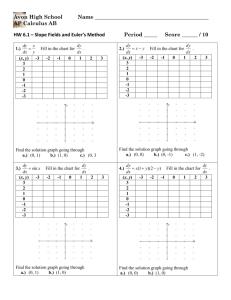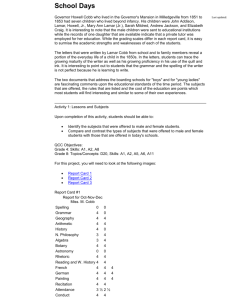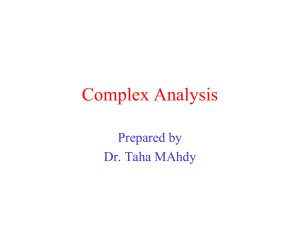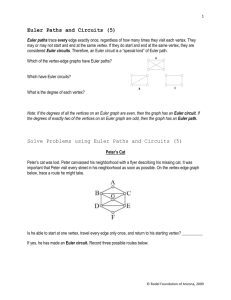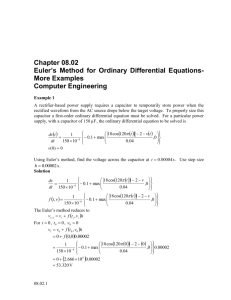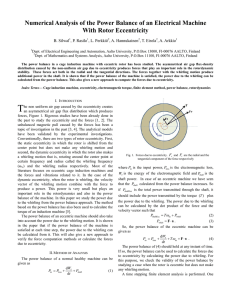h2 further math pure math…
advertisement
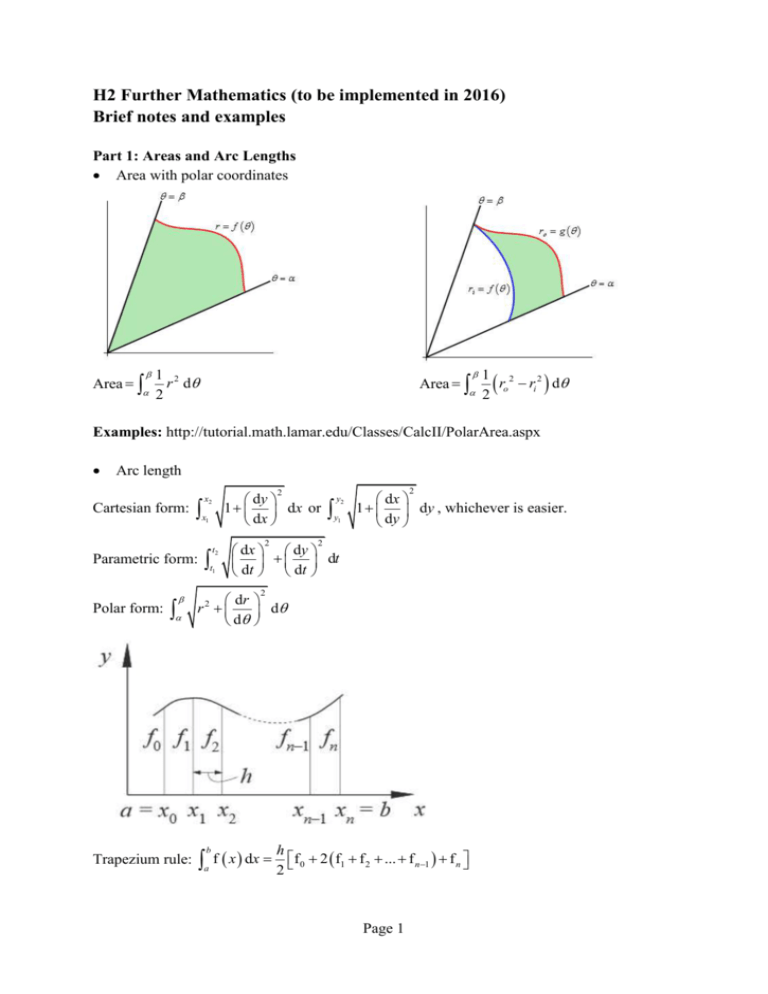
H2 Further Mathematics (to be implemented in 2016) Brief notes and examples Part 1: Areas and Arc Lengths Area with polar coordinates Area 1 2 r d 2 Area 1 2 ro ri 2 d 2 Examples: http://tutorial.math.lamar.edu/Classes/CalcII/PolarArea.aspx Arc length Cartesian form: 2 dy 1 dx or dx x2 x 1 Parametric form: t2 t 1 Polar form: Trapezium rule: 2 2 y2 y 1 dx 1 dy , whichever is easier. dy 2 dx dy dt dt dt 2 dr r2 d d h a f x dx 2 f0 2 f1 f 2 ... f n1 f n b Page 1 Simpson’s rule: h x f x dx 3 f0 4 f1 f3 ... f n1 2 f 2 f 4 ... f n2 f n xn 0 Note that n must be even. Examples: 1. http://www.mathwords.com/a/arc_length_of_a_curve.htm 2. http://www.stewartcalculus.com/data/ESSENTIAL%20CALCULUS%20Early%20Trans cendentals%202e/upfiles/instructor/ess_ax_0704.pdf Surface area of revolution Cartesian form: About x-axis, it is given by x2 x 1 2 dy 2 y 1 dx . dx 2 About y-axis, it is given by y2 y 1 dx 2 x 1 dy . dy Parametric form: About x-axis, it is given by t2 t 1 About y-axis, it is given by t2 t 1 2 y t 2 2 2 2 dx dy dt . dt dt dx dy 2 x t dt . dt dt Examples: 1. http://tutorial.math.lamar.edu/Classes/CalcII/SurfaceArea.aspx 2. http://www.phengkimving.com/calc_of_one_real_var/13_plane_curves/13_01_param_cur ves/13_01_03_arc_len_and_area_of_surf_of_revltn_of_param_curves.htm Part 2: Differential Equations Solve first-order linear DE via an integrating factor (IF) P dx dy Py Q (P and Q are functions in x), IF is e For DE of the form . dx Solve second-order homogeneous DE of the form a d2 y dy b cy 0 (a, b, c are 2 dx dx constants) First, solve the auxiliary equation (AE) am 2 bm c 0 to obtain the roots m1 , m2 . Case 1: If the roots are real and distinct, general solution (GS) is y Aem1x Bem2 x . Case 2: If m1 m2 m , GS is y emx Ax B . Case 3: If the roots are imaginary, say p qi , GS is y e px A cos qx B sin qx . Page 2 Solve second-order non-homogeneous DE of the form a d2 y dy b cy f x 2 dx dx d2 y dy GS has the form given by y u x v x where u x is GS of a 2 b c 0 (called dx dx complementary function or CF) and v x is some particular integral (PI). Case 1: f x is a polynomial of degree n PI is y an x n an 1 x n1 ... a1 x a0 . Try y an x n 1 an1 x n ... a1 x 2 a0 x (when c 0 ). The constants a0 , a1 , ..., an are found by differentiating twice and equating coefficients. Case 2: f x kemx PI is y Pemx . Try y Pxemx or y Px 2emx (when e mx is seen in CF). The constant P is found by differentiating twice and equating coefficients. Case 3: f x k1 cos rx k2 sin rx PI is y p cos rx q sin rx . Try y x p cos rx q sin rx (when cosrx and sin rx are seen in CF). The constants p and q are found by differentiating twice and equating coefficients. Case 4: f x is the sum or difference of functions from case 1 to 3. PI is the sum or difference of PIs from case 1 to 3. Examples: 1. http://www.stewartcalculus.com/data/CALCULUS%20Concepts%20and%20Contexts/up files/3c3-2ndOrderLinearEqns_Stu.pdf 2. http://www.stewartcalculus.com/data/CALCULUS%20Concepts%20and%20Contexts/up files/3c3-NonhomgenLinEqns_Stu.pdf Modelling with DE Examples: 1. http://tutorial.math.lamar.edu/Classes/DE/Modeling.aspx 2. http://www.stewartcalculus.com/data/CALCULUS%20Concepts%20and%20Contexts/up files/3c3-AppsOf2ndOrders_Stu.pdf Part 3: Numerical Methods Linear interpolation If f x 0 has a root between x x1 and x x2 , a better approximation of the root is x3 y2 x1 y1 x2 y1 y2 . Note: y1 f x1 , y2 f x2 and they have opposite signs. Page 3 Newton-Raphson method f xn xn 1 xn , f ' xn Iteration method xn1 F xn For example, x5 3x 2 8 0 leads to the iterative formula xn1 5 8 3xn2 . Euler’s method to solve first-order DE y' f x, y yi 1 yi h f xi , yi where h refers to the step size. Improved Euler formula (Heun’s method) h yi 1 yi f xi , yi f xi h, yi h f xi , yi 2 Examples: 1. http://www.cimt.plymouth.ac.uk/projects/mepres/alevel/pure_ch19.pdf 2. http://mat.iitm.ac.in/home/sryedida/public_html/caimna/ode/euler/euler.html 3. http://www.math.ksu.edu/math240/book/chap1/numerical.php Part 4: Complex Numbers H2 Mathematics Loci and Argand diagrams De Moivre’s theorem to find roots of z n c and derive trigonometric identities Examples: http://www.uea.ac.uk/jtm/6/Lec6p5.pdf Page 4 Part 5: Loci and Conics Page 5 Note: Eccentricity e 1 . Page 6 Note: If a b , we obtain a circle whose eccentricity e 0 . Page 7 Note: Eccentricity e c where c a2 b2 . Every hyperbola has eccentricity e 1 . a Page 8 Note: If A 0 or C 0 , we have a parabola. If A and C have the same signs, we have an ellipse. If A and C have opposite signs, we have a hyperbola. Examples: 1. http://www.mistergmath.com/uploads/2/2/9/1/22916464/unit_10_pg_743-816.pdf 2. http://www.stewartcalculus.com/data/ESSENTIAL%20CALCULUS%20Early%20Trans cendentals%202e/upfiles/instructor/ess_ax_0905.pdf Part 6: Matrices and Linear Spaces Notes and examples: 1. http://stattrek.com/tutorials/matrix-algebra-tutorial.aspx 2. http://www.maths.lse.ac.uk/personal/martin/fme2a.pdf 3. http://www.maths.lse.ac.uk/personal/martin/fme3a.pdf 4. http://www.maths.lse.ac.uk/personal/martin/fme4a.pdf 5. http://filestore.aqa.org.uk/subjects/AQA-MFP4-TEXTBOOK.PDF 6. http://web.science.mq.edu.au/~chris/matrices/CHAP07%20Diagonalisation.pdf Page 9



